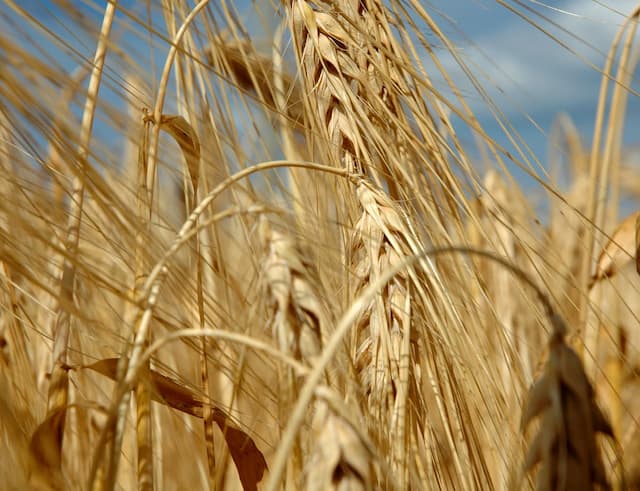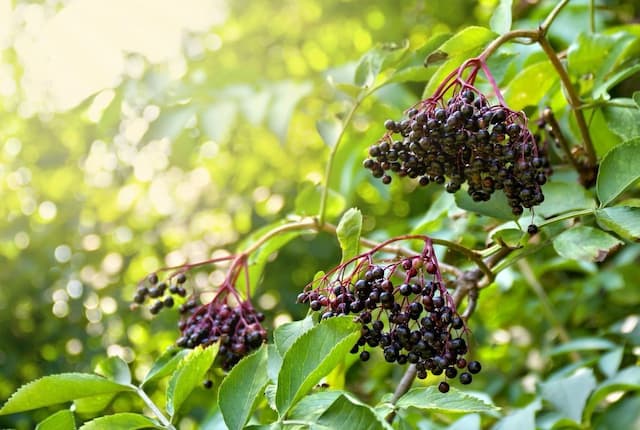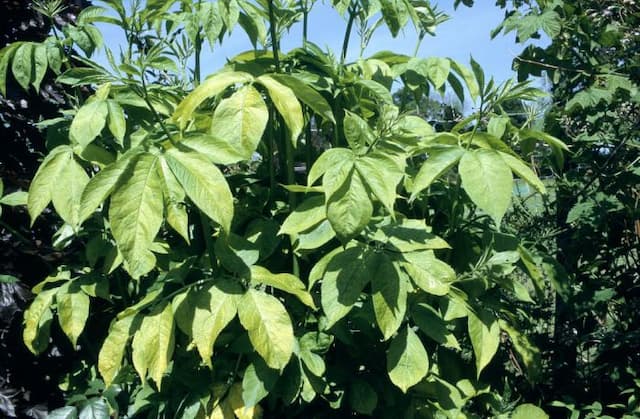Himalayan Snowball Viburnum grandiflorum f. foetens

ABOUT
The plant known commonly as Himalayan viburnum features a distinctive appearance that emanates both beauty and resilience. It boasts a lush foliage that remains richly green throughout much of the year. The leaves are broad, with a slightly wrinkled texture, and oval to oblong in shape with toothed edges, which can add a contrasting texture to any garden setting. During the flowering period, the plant comes alive with large clusters of blooms that may range from white to a soft, blush pink, exuding a sweet yet intense fragrance that is especially prominent on warm days. These flowers are typically arranged in rounded or slightly flat-topped clusters known as corymbs, and bring about a showy display that can attract various pollinators. After the flowering season, it produces berries that shift in color from red to a glossy black as they mature, providing visual interest and serving as a food source for birds and other wildlife. The bark of Himalayan viburnum is also notable, providing subtle texture with its furrowed appearance that can add to its ornamental value, especially during the leafless season. Overall, the unique combination of fragrant blooms, textured leaves, showy berries, and an attractive form makes the Himalayan viburnum a compelling choice for gardeners seeking year-round visual interest.
About this plant
 Names
NamesFamily
Adoxaceae
Synonyms
Himalayan Viburnum, Large-leaved Viburnum, Stinky Viburnum
Common names
Viburnum foetens (Wall. ex DC.) Kuntze, Viburnum grandiflorum Wall. ex DC.
 Toxicity
ToxicityTo humans
The plant in question, commonly known as Himalayan viburnum, may contain mildly toxic substances and can cause digestive distress if ingested. The symptoms of poisoning from Himalayan viburnum might include nausea, vomiting, diarrhea, and stomach cramps. It is advised to seek medical attention if any part of the plant is ingested and symptoms develop, as individual reactions can vary.
To pets
Himalayan viburnum is also considered to be mildly toxic to pets. If ingested by animals, it can cause similar symptoms as in humans, including vomiting, diarrhea, and possibly drooling or abdominal pain. It is important to contact a veterinarian if your pet has eaten any part of this plant and exhibits these symptoms, as they can provide the appropriate care and treatment.
 Characteristics
CharacteristicsLife cycle
Perennials
Foliage type
Deciduous
Color of leaves
Green
Flower color
White
Height
10-15 feet (3-4.5 meters)
Spread
10-15 feet (3-4.5 meters)
Plant type
Shrub
Hardiness zones
7
Native area
Himalayas
Benefits
 General Benefits
General Benefits- Landscape Aesthetics: Provides ornamental value with its large, showy flowers and can enhance the visual appeal of gardens and landscapes.
- Habitat for Wildlife: Offers food and shelter for birds, insects, and other wildlife, contributing to local biodiversity.
- Erosion Control: Its root system can help stabilize soil on slopes, reducing the risk of soil erosion.
- Seasonal Interest: Produces colorful berries and foliage changes that add seasonal interest to the landscape throughout the year.
- Hedging and Screening: Can be used to create natural privacy screens or hedges due to its dense growth habit.
- Low Maintenance: Typically requires minimal care once established, making it a convenient choice for gardeners of all levels.
- Cultural Significance: May hold cultural importance in certain regions or traditions, adding to the plant's value in these contexts.
- Drought Tolerance: Once established, it can tolerate periods of drought, reducing the need for frequent watering.
 Medical Properties
Medical Properties- Anti-inflammatory: The plant is traditionally used to reduce inflammation.
- Antispasmodic: Viburnum grandiflorum f. foetens may have properties that alleviate spasms.
- Analgesic: There are claims that it may be used for pain relief.
- Antipyretic: It might be used to reduce fever.
- Sedative: It may have a calming effect, helping to alleviate restlessness and insomnia.
- Anticonvulsant: It might help in the treatment of seizures or convulsions.
- Astringent: The plant may be used for its tightening effect on tissues.
 Air-purifying Qualities
Air-purifying QualitiesThis plant is not specifically known for air purifying qualities.
 Other Uses
Other Uses- Viburnum grandiflorum, commonly known as 'Himalayan snowball', can be used as a natural hedge or privacy screen due to its dense foliage.
- The plant's wood is sometimes used in fine woodworking for making small decorative items or inlays that require hard, durable wood.
- Known for its showy flowers, the Himalayan snowball can be cultivated for use in cut flower arrangements.
- The dense branching habit of the plant allows it to be used in shelterbelts or windbreaks, providing protection from erosive winds.
- The leaves of the plant sometimes serve as a natural mulch, decomposing and enriching the soil as they fall.
- Because of its attractive and dense foliage, the Himalayan snowball is used in ornamental gardens as a backdrop for other flowering plants.
- The plant can be trained into topiary shapes, making it a versatile addition to formal gardens.
- In regions where it's native, the Himalayan snowball is incorporated into traditional rituals and ceremonies as a decorative plant.
- Due to its height and layered branches, the plant can be used in sound barrier plantings to reduce noise pollution.
- Its berries, although not commonly consumed, can be used to make a natural dye for fabrics or crafts.
Interesting Facts
 Feng Shui
Feng ShuiThe Himalayan Viburnum is not used in Feng Shui practice.
 Zodiac Sign Compitability
Zodiac Sign CompitabilityThe Himalayan Viburnum is not used in astrology practice.
 Plant Symbolism
Plant Symbolism- Renewal and Growth: Viburnum, in general, is associated with the spring season, representing the ideas of renewal and the beginning of a growth cycle. The blooming of its flowers signifies new opportunities and the refreshing of life's journey.
- Protection: Some cultures believe viburnums to be a symbol of protection due to their robust nature and the way some species have been used in hedgerows to provide shelter and boundaries.
- Abundance and Fertility: With its large, lush clusters of flowers and berries, Viburnum can denote abundance and fertility, implying a generous nature or a fruitful period in someone's life.
- Family and Home: The Viburnum's ability to attract wildlife, like birds who eat the berries, gives it a connection to the home and the nurturing of family ties, suggesting a space that welcomes and sustains life.
 Water
WaterThe Himalayan snowball, commonly known as Viburnum grandiflorum, should be watered deeply and less frequently to encourage the growth of a strong root system. Water the plant with approximately 1 to 1.5 gallons of water every week during its active growing season in spring and summer, ensuring that the soil is moist but not waterlogged. In the fall and winter, reduce watering to every two weeks depending on the weather and soil moisture levels. Adjust the frequency if rainfall is sufficient, ensuring the shrub does not sit in soggy soil to avoid root rot.
 Light
LightThe Himalayan snowball prefers partial to full sunlight for robust growth. It thrives in a location that receives at least 4 to 6 hours of direct sunlight each day, though it can tolerate light shade. Avoid deep shade conditions as it may lead to less vigorous growth and fewer blooms.
 Temperature
TemperatureThe Himalayan snowball can survive in a wide range of temperatures but prefers a cooler climate, thriving best in USDA Hardiness Zones 7 to 9. It can withstand short periods of temperatures as low as 0°F, but it is ideal to maintain a temperature above 20°F. To ensure maximum health and flowering, keep it in an environment where the average temperature ranges between 60°F and 75°F.
 Pruning
PruningTo maintain shape and health, the Himalayan snowball should be pruned immediately after it finishes flowering typically in late spring or early summer. Pruning at this time allows for new growth that will produce next year's blooms. Remove any dead, diseased, or crossing branches to improve air circulation and light penetration within the canopy. Pruning can be performed annually or as needed to control size and encourage vibrant blooms.
 Cleaning
CleaningAs needed
 Soil
SoilHimalayan Snowball needs well-draining soil with a pH of 5.5 to 6.5. The best mix is equal parts of garden soil, compost, and perlite or coarse sand to ensure proper drainage and fertility.
 Repotting
RepottingHimalayan Snowball should be repotted every 2-3 years or when the plant has outgrown its current container, ensuring it continues to thrive and grow healthily.
 Humidity & Misting
Humidity & MistingHimalayan Snowball prefers moderate to high humidity levels. Aim to maintain humidity around 40-60% for the best growth conditions.
 Suitable locations
Suitable locationsIndoor
Provide bright indirect light and water when the topsoil feels dry.
Outdoor
Plant in partial shade, mulch well, and protect from strong winds.
Hardiness zone
7-9 USDA
 Life cycle
Life cycleViburnum grandiflorum f. foetens, commonly known as Himalayan viburnum, begins its life cycle when seed germination occurs in the presence of appropriate conditions such as a well-draining soil and warmth. After germination, the seedling emerges and establishes itself, growing into a young plant with characteristic foliage. As it matures, the Himalayan viburnum enters a vegetative stage, where it develops a strong root system, stems, and leaves. Following this, the plant reaches the flowering stage, typically producing fragrant flowers that attract pollinators and are subsequently followed by the formation of berries or drupes. These fruits, when mature, disperse seeds either through animal consumption and excretion or through natural mechanisms such as gravity or wind. The dispersed seeds then close the life cycle loop as they are sown into the ground, maintaining the population of the Himalayan viburnum through seedling recruitment.
 Propogation
PropogationPropogation time
Spring
The most popular method of propagation for Viburnum grandiflorum f. foetens, commonly known as Himalayan Viburnum, is by softwood cuttings. This is typically done in late spring or early summer when new growth is still tender and green. Cuttings about 6 to 8 inches (15 to 20 centimeters) long are taken from the new growth, and the lower leaves are removed. The cut end of the cutting is then dipped in rooting hormone to encourage root development and planted in a well-drained soil mix. The cuttings should be kept moist and in a warm environment with indirect sunlight until roots have developed, which usually takes several weeks.



![Elder [Black Tower]](/_next/image?url=https%3A%2F%2Fplants-admin.emdemapps.com%2Fimages%2Fplants%2F%2Fimages%2F604b5cad99578.png&w=640&q=75)





